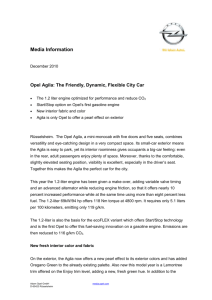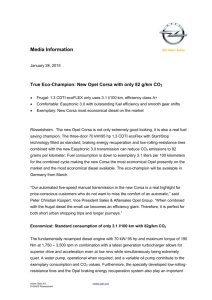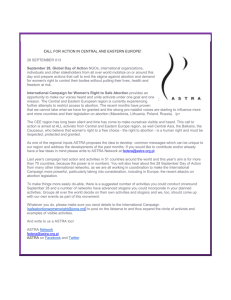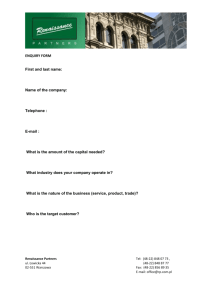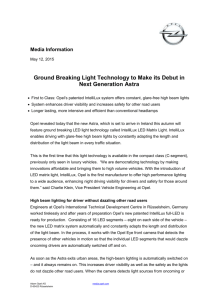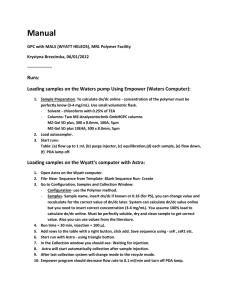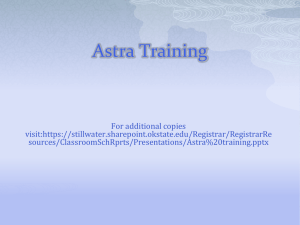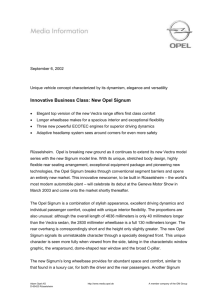definition American Marketing Association
advertisement
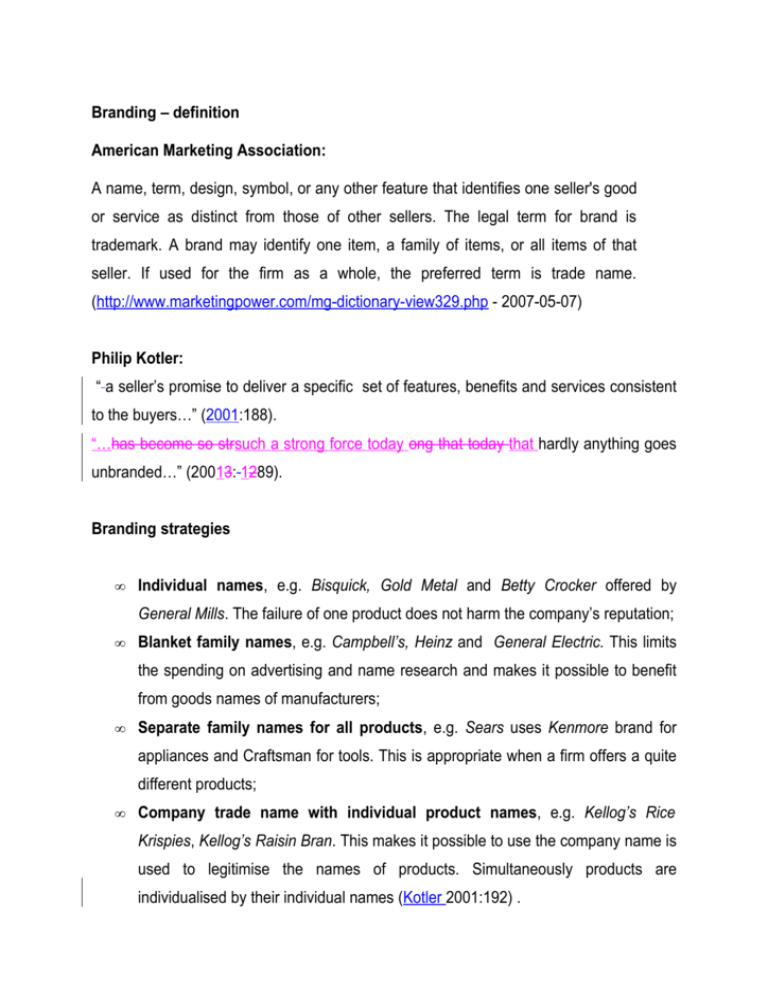
Branding – definition
American Marketing Association:
A name, term, design, symbol, or any other feature that identifies one seller's good
or service as distinct from those of other sellers. The legal term for brand is
trademark. A brand may identify one item, a family of items, or all items of that
seller. If used for the firm as a whole, the preferred term is trade name.
(http://www.marketingpower.com/mg-dictionary-view329.php - 2007-05-07)
Philip Kotler:
“ a seller’s promise to deliver a specific set of features, benefits and services consistent
to the buyers…” (2001:188).
“…has become so strsuch a strong force today ong that today that hardly anything goes
unbranded…” (20013: 1289).
Branding strategies
•
Individual names, e.g. Bisquick, Gold Metal and Betty Crocker offered by
General Mills. The failure of one product does not harm the company’s reputation;
•
Blanket family names, e.g. Campbell’s, Heinz and General Electric. This limits
the spending on advertising and name research and makes it possible to benefit
from goods names of manufacturers;
•
Separate family names for all products, e.g. Sears uses Kenmore brand for
appliances and Craftsman for tools. This is appropriate when a firm offers a quite
different products;
•
Company trade name with individual product names, e.g. Kellog’s Rice
Krispies, Kellog’s Raisin Bran. This makes it possible to use the company name is
used to legitimise the names of products. Simultaneously products are
individualised by their individual names (Kotler 2001:192) .
Features of a good brand name
•
suggest the products benefits and qualities, e.g. DieHard, Sunkis and Craftsman;
•
be easy to pronounce, recognise and remember, e.g. short names like Tide, Aim
or Puffs;
•
be distinctive, e.g. Kodak, Exxon and Oracle;
•
be extendable, e.g. Amazon.com expanded from a bookseller into other
categories;
•
not carry poor meanings in other countries and languages, e.g. Nova means
“doesn’t go” in Spanish (based on Armstrong and Kotler 2003:290-291, Kotler
2001:192).
Branding - successes and failures:
•
FIAT Panda (1980) – It was checked that the name was pronounced in a similar
way in eight major languages of the world. (Metelski 1980).
•
Rolls Royce Silver Mist – the name means “silver animal dropping” in German and
it did not sell well in Germany (Haig 2006:181).
•
Chevy Nova (i.e. Chevy cannot do it) ) not selling well in Latin America (Haig
2006:181).
Brand as a linguistic message
Disciplines involved in branding: Marek
• etymology
• lexical statistics
• lexicology
• logic
• neology
• onomastics
• phonetics
• pragmatics
• psycholinguistics
• rhetoric
• semantics
• semiotics
• sociolinguistics
•
word formation (Kall 2001:19)
Structural elements of a brand:
•
Brand contents, i.e. the persuasive and promotional message that consists of
and idea, a message and the contents the brand conveys.
•
Brand form, i.e. a linguistic sign that functions on three levels:
Linguistic record – type, colour, size of letters, symbols, motifs and design;
Form of the linguistic sign – meaning, position in the name, repetitiveness,
combination of letters, length of the name its internal, symmetry
Meaning of the linguistic sign – the lexical formula, stylistic and semantic
values (Kall 2001:150)
Classification of brands
•
Transferred names – existing lexemes, mainly common and proper nouns,
adjectives and numerals are equipped with some new meaning related to the
products they give name to, e.g. Golf is a transfer of a noun denoting a game
onto a car model. One may say that the semantic field of the existing lexemes is
enlarged by the organisation creating the brand.
•
Invented names which include acronyms like Microsoft, abbreviations like IBM ,
words created by the removal of an affix or suffix, e.g. fanta-stic – Fanta. In fact
they are “…semantically empty but phonotactically correct combinations of letters
or whole words…” (Zboralski 2000: 139).
A more elaborate classification of brands is also given by the same author.
Brand character - method of transferring Examples
the message
Descriptive (semantic) Direct motivation through the meaning of
Lux
words
Suggestive (relative)
Allusion, connotation., suggestion
Dr Witt,
Mustang
Symbolic (emblematic) Symbol contents
Gold, Ivory
Arbitrary (speculative) Motivation:
Hit, Renault
• hidden from the receiver
• free (accidental
• image based
Artificial (non-semantic) No motivation
Adidas, Kodak
(own study based on Zboralski 2000:80)
Brand type
Kosyl - chrematonimy
•
proper names transferred form one class to another in the process of
transonimisation, e.g. the name Aramis being originally a literary character and
then a product name;
•
common names transferred to the class of proper names, eg. golf → Golf;
•
word formation, often bearing the connotations of technical or scientific
vocvabulary, e.g. Pianon (Kosyl 2001:449-450)
Sound symbolism
“…individual sounds are thought to reflect, or symbolize the properties of the world and
thus ‘to have meaning’…” (Crystal 2005 a:176).
Fernando Dogana:
•
a, o, u express heaviness and slowness but also round shapes,
•
i suggests dynamism and sharp shapes,
•
e expresses dynamism and round shapes,
•
sounds are more important that letters in the process of communicating of the
brand. Thus, the name AKSE has the same number of sounds as the name
RENAULT, which has more letters (after Kall 2001:151
Stanford University research
sound/ feature
slowness
speed
large and luxurious
small and
uncomfortable
pleasant feelings
unpleasant feelings
b
+
- Connotations of sounds
d
+
f
g
k
l
p
+
r
+
+
t
+
+
+
+
+
+
+
+
s
+
+
z
+
+
+
+
+
+
+
v
+
+
(own study based on: http://www.stanford.edu.class/linguists34/unit_08blackberry.htm.
Acessed: 2005-11-29)
Match the two words:
NALUMA & TAKETA
with the shapes below:
TAKETA
NALUMA
↓
↓
• Taketa – all consonants are onstruents. Obstruents are perceived as hard and
sharp.
Compare: Clorox – laundry product.
• Naluma – all consonants are sonorants. Sonorants are perceived as soft and
smooth.
Compare: Chanel perfume.
Based on http://www.lexicon-branding.com/process2aSound.html. 2005-11-14
Phonotactics
•
Jerzy Bralczyk,: a perfect name begins and ends with a vowel, e.g. Alba
(2000:77).
•
ZIMA of (Russian vodka sold in the western markets):
The name is short because it consists of two syllables and the syllables
form the same set: consonant + vowel (C+V) creating the widely preferred
pattern CVCV .
In addition to that the pattern:
accented syllable + unaccented syllable
is also used in English for creating nicknames which gives the name an
individual character
(based on: http://lexicon-branding.com/process2bAnatomy.html. Accessed: 200511-14).
OPEL cars
Letters as classification devices
•
The names of vans end with the - o grapheme [Combo, Movano, Vivaro].
•
The names of cars end with the - a grapheme [Corsa, Astra].
Sound symbolism
•
Most of the names of OPEL models contain sounds suggesting dynamism and speed, e.g. [s]
in Astra, Corsa, Signum , [v] in Vectra and Meriva or [z] in Zafira. These sounds are absent in
Agila, which in turn contains [g] sound suggesting it is large and luxurious and [l] sound that has
the connotations of pleasant feelings. Antara and GT seem to fail the test. Both of them contain
the [t] sound suggesting: small, uncomfortable and unpleasant feelings. The [g] sound in GT
suggests it is large and luxurious, which is not altogether true but, at least it compensates the
negative connotations of the neighbouring [t] sound.
•
Names like Agila, Meriva, Movano, Vivaro do not contain voiceless sounds at all. Generally
speaking the names are dominated by vowels. Vowels are voiced , which seems makes the
names distinctive and seems to give them with some power or, voice versa express the power
of cars bearing the “voiced names”.
•
The [r] sound is absent only in the names of four models. The sound is classified as an
unpleasant one but to many people it may have the connotations of the engine noise and of
such sports cars like Ferrari or Porsche. This may possibly explain why the [r] sound does not
occur in the names of van s [Combo, Movano], the name of a city car [Agila] and in the
distinguished, elegant and quiet Signum.
•
The [a] sound is present in the names of most of the models. Crystal Crystal(2005a) indicates
that such an open vowel may indicate largeness as opposed to close vowels (2005a:177). One
has to bear in mind that “…female names tend to end in a (spoken) vowel…” (Crystal 2005 [b] :
1532). The [a] ending is definitely connected with female Christian names and this may be a
major cultural issue for a car manufacturer operating across cultures. One should also
remember the quoted above Dogana’s concept about [a]suggesting heaviness and slowness.
•
The names of vans [Combo, Movano] do not contain “dynamic” sounds. This may create their
image of “working horses”, also stressed by the occurrence of the [o]sound.
•
Vivaro is offered in two versions - one of them is designed to carry cargo and the other is
supposed to carry people and to possess the features of a “normal” car Therefore, its name
contains “dynamic” [i]and [v] as well as the “heavy” [o].
Phonotactic features
•
smaller models have names that consist of 5 graphemes and 5 sounds [Agila,
Corsa, Astra] while bigger cars have 6 graphemes and 6 sounds [Vectra, Signum,
Meriva]. One may say that the number of sounds and graphemes is a way of
categorizing the fleet of offered cars.
•
It is also the number of the syllables that plays a similar sole. No single name is
longer than 3 syllables following the concept of a short and easy to remember
brand. The basic models have two-syllable names [Corsa, Astra, Vectra, and
Signum]. Three syllables form a separate category of cars of [Agila, Meriva and
Zafira] + [Movano, Vivaro]. The relationship of vowels to consonants (V:C) is well
balanced
•
Only three names contain closed syllables, which may slow down their
pronunciation and it is only Signum which is exceptional again and consists of
closed vowels only.
•
All the names used by OPEL avoid long clusters of consonants. Astra, and Vectra
contain 3 consonant cluster while Corsa, Tigra, Signum and Combo contain 2
consonant clusters and Agila, Vivaro and Movano do not contain clusters of
consonants at all. No cluster of consonants is placed at the beginning or end of
the name thus making it aest to pronounce.
•
Agila, Astra and Antara are perfect because they start and end with a vowel Jerzy Bralczyk’s criteria (2000:77)
V:C relationship in the analysed names
V:C
3:2
2:3
Models
Agila
Corsa, Astra, Tigra, Vectra, Signum,
3:3
Combo
Antara, Meriva, Movano, Vivaro, Zafira,
Semantic features of the analysed names
•
reference to an object outside the world of the motor industry: Agila, Astra,
Combo, Corsa, Frontera and Signum. English origin [Combo], Latin origin [Astra
and Signum] Spanish {origin][ Agila, Corsa and Frontera].
•
the number of transferred names (6: Agila, Astra, Corsa, Signum , Tigra and
Combo ) is well balanced with the invented ones (6: Antara, Meriva, Vectra,
Zafira, Movano, Vivaro).
• Domains from transfer is made:
- a total lack of geographical names, used by SEAT e.g. Cordoba, Ibiza or
games / winds as used by Volkswagen e.g. Polo, Golf, Passat, Scirocco.
- The sources: fauna (Agila, Tigra), astronomy (Astra) entertainment (Corsa)
or music (Combo).
- positive or at least neutral connotations – see the names used by some
competitors, i.e. “biting and poisonous” names like Cobra or Scorpio or the
Probe one which brings about both space exploration and medical test
connotations.
OPEL vans – a summary of major linguistic features
COMBO
No of graphemes
No of sounds
No. of vowels
V:C
Pattern of syllables
Meaning
Language
Connotations
5
5
2
2:3
CVC+CV
A group of
musicians
English
Music, fun
Type of name*/
Noun
Invented/ tranferred (from) **/
Suggestive
Common
Tranferred (Music)
* based on Zboralski (2000:80)
** based on Kosyl (2001: 249-250)
MOVANO
6
6
3
3:3
CV+CV+CV
VIVARO
6
6
3
3:3
CV+CV+CV
Move, moving
in/out, moving on
Lively, exciting,
attractive
Viva Maria !
Artificial, suggestive Artificial, suggestive
Invented
Invented
OPEL car names – a summary of linguistic features
AGILA
ANTARA
ASTRA
CORSA
MERIVA
Vehicle
mini
SUV
car
car
SUV
type
SUV
No of
grapheme
5
6
5
5
6
s
No of
5
6
5
5
6
sounds
No of
3
3
2
2
3
syllbales
V:C
3:2
3
2:3
2:3
3:3
Pattern of
CV+CV
V+CV+C Vc+CV+ VC+CC CVC+C
syllables
+
V
CV
V
V
CV
Meaning
Eagle
Stars
Race
Language Spanish
Latin
Spanish
Connotations Agility
(agile-)
Type of
name*/
Suggestiv
e
Noun
Invented/
transferred
**/ (from)
Common
Transf.
(Fauna)
artificial
Invented
Success
and
achievem
ent Per
aspera
ad
astram
Arbitrary Suggestiv artificial
e/
arbitrary
Common Common
Transf.
Transf.
Invented/
(Astrono (Sport /
my)
entertain
ment)
SIGNUM
TIGRA
VECTRA
ZAFIRA
car
sports
car
car
SUV
6
5
6
6
6
5
6
6
2
2
2
3
2:3
2:3
2:3
3:3
CV+CV
CVC+C CV+CC CVC+C
+
VC
V
CV
CV
Sign
Tigress
Latin
German
Tiger –
power ,
predacity
Victor,
power,
science
Symbolic / suggestiv
arbitrary e
Suggestiv artificial
e/
arbitrary
Transf.
(Semiotic
s)
Invented
Transf.
(Fauna)
Invented
* based on Zboralski (2000:80)
** based on Kosyl
Bibliography
•
Altkorn Jerzy.1997. Strategia marki. Warszawa: Polskie Wydawnictwo Ekonomiczne
S.A.
•
Bartosik Małgorzata. 2001. „Marka na rynkach zagranicznych” . Marketing w
praktyce. Lipiec 2001. nr 7. str. 49-52.
•
Bolinger, Dwight. 1949. „The Sign is Not Arbitrary”. Boletin del Instituto Caro y
Cuervo 5: 56-62.
•
Bralczyk Jerzy. 2000. Język na sprzedaż. Warszawa-Bydgoszcz: Oficyna Wydawnicza
Banta.
•
Collins COBUILD English Dictionary for Advanced Learners, Harper Collins
Publishers 2001.
•
Crystal David. 1995. The Cambridge Encyclopedia of The English Language.
Cambridge University Press.
•
Crystal David. 1997. The Cambridge Encyclopedia of Language. Cambridge
University Press.
•
Garbarski Lechosław, Rutkowski Ireneusz, Wrzosek Wojciech, 1996. Marketing.
Punkt
zwrotny
nowoczesnej
firmy.
Warszawa:
Państwowe
Wydawnictwo
Ekonomiczne.
•
Grzesiuk Aleksandra. 2001. „Produkt dobrze nazwany”. Marketing w praktyce.
Kwiecień 2001.Nr 4. str. 26-28.
•
Hiam Alexander. 1999. Marketing dla opornych. Warszawa: Wydawnictwo RM.
•
Humpboldt, Wilhelm von. 1836. Über die Verschedenheit des menschlichen
Sprachbaues und ihren Einluß auf die geistige Entwicklung des Menschengeschlechts.
Druckerei der Königlichen Akademie, Berlin. Reprinted: Bonn: Dummler 1960.
•
Kall Jacek. 2001. Silna marka. Istota i kreowanie. Warszawa: Polskie Wydawnictwo
Ekonomiczne.
•
Kotler Philip. 1994. Marketing. Analiza, planowanie, wdrażanie i kontrola. Warszawa:
Gebethner i S-ka.
•
Kotler Philips. 1999. Kotler o marketingu. Jak kreować i opanowywać rynki. Kraków:
Wydawnictwo Profesjonalnej Szkoły Biznesu.
•
Kotler Philip, Armstrong Gary. 1993. Marketing. An Introduction. Englewood Cliffs
N.J.: Prentice Hall.
•
Haig Matt. 2006. Porażki marek. Największe wpadki rekinów biznesu. Warszawa:
Bellona.
•
MacMillan English Dictionary for Advanced Learners. Macmillan Publishers Limited
2002.
•
Magnus, Margaret. 1999. Gods of the Word : Archetypes in the Consonants. Truman
State University Press, July 1999.
•
Metelski Jerzy “Miejsce dla pandy” w: Przegląd techniczny 13/1980 pp.24-27
•
Mruk Henryk, Rutkowski Ireneusz P. 1999. Strategia produktu. Warszawa:
Państwowe Wydawnictwo Ekonomiczne.
•
Plato.1961. “Cratylus” w: Edith Hamilton and Huntington Cairns (eds.) Plato, the
Collected Dialogues. Princeton University Press.
•
Reece Barry L., O’Grady James. 1987. Business. Boston: Houghton Miffin Company.
•
Rodek-Słowińska Anna. 2004. Linguistic Aspects of Names in the Motor Industry.
Katowice: Wyższa Szkoła Zarządzania Marketingowego i Języków Obcych. Praca
magisterska niepublikowana.
•
Romański Wojciech. 2000. „Jak znaleźć imię. Nie zginąć w tłumie” Businessman.
Sierpień 2000, str. 48-49.
•
Sapir, Edward. 1929. „A Study in Phonetic Symbolism”. Journal of Experimental
Psychology 12: 225-239.
•
Sieczkowski Grzegorz. 1997. „Produkt dobrze nazwany.” Businessman. Luty 1997.
str. 66-68.
•
Sinclair John (ed.). 2001. Collins Cobuild English Dictionary for Advanced Learners.
Glasgow: Harper Collins Publishers.
•
Urbanek Grzegorz.2000. „Tworzenie silnej marki cz .I”. Marketing w praktyce.
Lipiec/sierpień 2000. Nr 4(32). Str. 47-49.
•
Urbanek Grzegorz.2000. „Tworzenie silnej marki cz. II”. Marketing w praktyce.
Lipiec/sierpień 2000. Nr 5 (33). Str. 17-19.
•
Zboralski Marek. 2000. Nazwy firm i produktów. Warszawa: Polskie Wydawnictwo
Ekonomiczne S.A.
•
http://www.opel.com/ dostępny 2005-12-10.
•
http://www.opel.com.pl/site/commercial/vivaro/desc1.html dostępny 2005-12-10.
•
http://www.opel.com.pl/site/showroom/signum/desc1.html dostępny 2005-12-10.
•
http://www.opel.de/shop/cars/antara/index.act 2007-05-21
